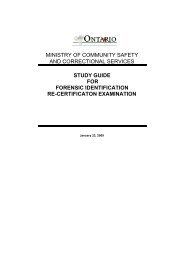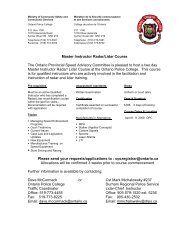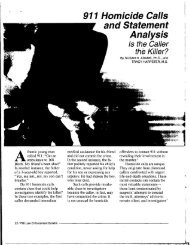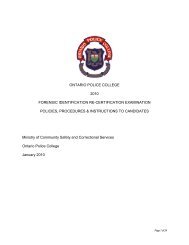General Study Guide - Ontario Police College
General Study Guide - Ontario Police College
General Study Guide - Ontario Police College
Create successful ePaper yourself
Turn your PDF publications into a flip-book with our unique Google optimized e-Paper software.
Development of Latent Prints on Thermal Paper - Manual of use for ThermaNin<br />
Introduction<br />
Thermal paper, once mainly used as fax paper only, is now used in many applications. These days it is used in ticket dispensers for giving out<br />
queue numbers or parking tickets, in label printers, and printers for point-of-sales receipts at retail shops like supermarkets.<br />
Thermal paper turns black on application of heat (as in the printer) but also on contact with polar solvents like alcohols, acetone, ether,<br />
ethyl acetate etc. The regular solutions of fingerprint reagents like ninhydrin and DFO are either based on a polar solvent (ninhydrin in ether<br />
or acetone for example) or rely on certain amounts of these polar solvents to dissolve them when used in an apolar bulk solvent like<br />
petroleum ether or heptane.<br />
These solutions have a detrimental effect on thermal paper: on application the paper surface turns dark grey or black thereby obscuring any<br />
fingerprints that may subsequently develop.<br />
There are only a few techniques known for developing fingerprints on thermal paper:<br />
<br />
<br />
<br />
<br />
1,2-IND (as a 2 g/l solution in HFE-7100 containing 7% ethyl acetate) has been reported to develop fingerprints without darkening<br />
the top (active) layer of the thermal paper (John Stimac, Journal of Forensic Identification, 2003, 53(3), 265-271). For finding and<br />
photographing the developed prints a Polilight or similar light source is needed.<br />
DMAC (dimethylaminocinnamaldehyde) fumes react with fingerprints on thermal paper (see e.g. Brennan et al., Journal of Forensic<br />
Identification, 1995, 45(4), 373-380). The fluorescence of any developed prints can be photographed with green light (Polilight,<br />
around 530 nm).<br />
Exposure to the fumes of concentrated hydrochlorid acid was reported to develop prints on the top layer of thermal paper (Broniek,<br />
Knaap, Journal of Forensic Identification, 2002, 52(4), 427-432). It will not develop prints on the back of thermal paper.<br />
Treatment with a regular ninhydrin solution and after allowing ample time for development of fingerprints, rinsing the paper with an<br />
excess of acetone to remove all the text and/or grey-black stains.

















